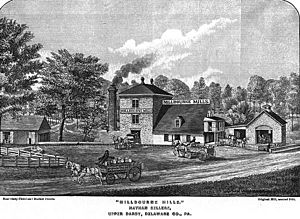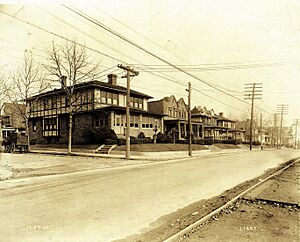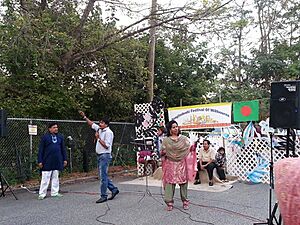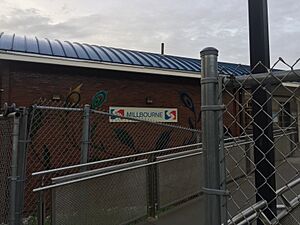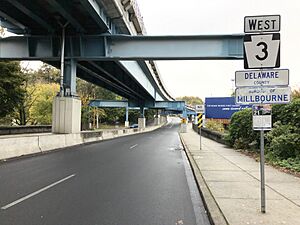Millbourne, Pennsylvania facts for kids
Quick facts for kids
Millbourne
|
|
|---|---|
| Millbourne Borough | |
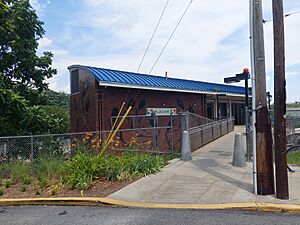
The Market–Frankford Line in Millbourne
|
|
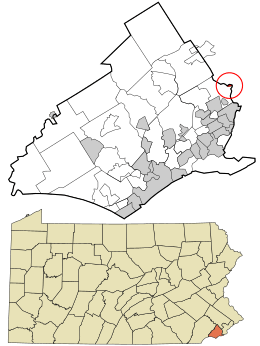
The location of Millbourne in Delaware County, Pennsylvania (top) and within Pennsylvania (bottom)
|
|
| Country | |
| State | |
| County | Delaware |
| First settled | 1682 |
| Incorporated | 1909 |
| Founded by | Samuel Shoemaker, John L. Fry |
| Named for | Millbourne Mills |
| Seat | Millbourne Borough Hall |
| Government | |
| • Type | Mayor–council government |
| • Body | Millbourne Borough Council |
| Area | |
| • Total | 0.074 sq mi (0.19 km2) |
| • Land | 0.074 sq mi (0.19 km2) |
| • Water | 0.00 sq mi (0.00 km2) |
| Elevation | 128 ft (39 m) |
| Population
(2020)
|
|
| • Total | 1,212 |
| • Density | 16,378.38/sq mi (6,313.42/km2) |
| Demonym(s) | Millbournian |
| Time zone | UTC-5 (EST) |
| • Summer (DST) | UTC-4 (EDT) |
| ZIP code |
19082
|
| Area codes | 610 and 484 |
| FIPS code | 42-49504 |
Millbourne Borough is a small, self-governing town in Delaware County, Pennsylvania, United States. In 2020, about 1,212 people lived there. Millbourne is right next to Philadelphia along a stream called Cobbs Creek. Its name comes from "Mill" and "bourne," which means creek.
Millbourne was first settled in 1682 by Samuel Sellers. His family later owned a gristmill (a mill for grinding grain) called Millbourne Mills. In the early 1900s, Samuel Shoemaker and John L. Fry built houses here. This led to Millbourne becoming its own official town, separate from Upper Darby, in 1909. The Millbourne Mills closed in 1926. A large Sears store took its place, but it moved away in 1988. This caused money problems for Millbourne. The town was listed as financially struggling in 1998 but got off that list in 2014.
Over time, many different groups of people have lived in Millbourne. First, there were Greek Americans, then East Asian Americans. Today, a large number of South Asian Americans call Millbourne home. In fact, Millbourne has the highest concentration of South Asian people in the entire United States.
Millbourne has its own train station, Millbourne Station, which is part of the SEPTA system. The town also had its own police and fire departments since 1909. However, the Millbourne Fire Company stopped operating in 2019. In 2022, the old Sears site was redeveloped. It is now a logistics (delivery and storage) facility for the Children's Hospital of Philadelphia.
Contents
History of Millbourne
Early Settlement
Before Europeans arrived, the Lenape people lived in the Delaware Valley. In 1682, Samuel Sellers came from England. He and his brother George bought land from William Penn. Samuel Sellers was a skilled weaver. He started America's first twisting-mill, which made thread. His son and grandson, John, continued the family's weaving business.
The Millbourne Mills
In 1752, John Sellers saw that Cobbs Creek could power mills. He developed several sites along the creek. These sites helped the Millbourne Mills grow. The mills were first called Sellers Mills.
Millbourne was part of Darby Township. But in 1786, it became part of Upper Darby Township. After John Sellers passed away in 1804, his sons took over the mills. The mills ground different grains like wheat and corn. The mill was expanded and improved over the years. It even used steam power later on. The mills produced a lot of flour every day.
Millbourne in the 1900s
In 1906, some land in Millbourne was sold to build the 69th Street Transportation Center. This connected Upper Darby to Philadelphia.
In 1907 and 1908, builders Samuel Shoemaker and John L. Fry developed a new community. They built many semi-detached homes (houses that share a wall with another house). These homes had nice lawns and tree-lined streets. Many families bought these homes quickly.
In 1909, Millbourne officially became a borough. It was the fourth borough formed in Upper Darby. The Millbourne Fire Company and Police Department started soon after. The Philadelphia Transportation Company (now SEPTA) opened a train station in Millbourne in 1907.
In 1910, Millbourne Mills was sold and continued to make flour until 1921. The mills closed in 1926. A large Sears Roebuck & Co. store was built in its place.
Millbourne students used to go to schools in the Millbourne School District. But in 1971, the Millbourne School District joined with others to form the Upper Darby School District.
Financial Challenges and Recovery
The Sears store operated from 1926 until 1988. When Sears moved to Upper Darby, Millbourne lost a lot of money. The town used to collect parking fees from the Sears parking lot, but that stopped too.
Because of these money problems, Millbourne was close to bankruptcy. In 1993, the state of Pennsylvania declared Millbourne a "financially distressed municipality." This meant the state would help the town recover. A plan was made to improve how the town managed its money. This included hiring a town manager and improving computer systems. Taxes for homeowners in Millbourne increased during this time.
Millbourne in the 2000s
Millbourne was still struggling financially in the early 2000s. Since the 1970s, more and more South Asian people moved to Millbourne. After the September 11 attacks, many Sikh taxi drivers from New York moved to Millbourne for safety. Millbourne became a safe place for the growing Sikh community because it had good services and a gurdwara (Sikh temple). Millbourne became known as "Little India."
In 2009, Millbourne started using a land value tax. This meant they taxed the land itself, not the buildings on it. This helped the town raise money. The old Sears lot became a big source of income. On October 21, 2014, Millbourne was removed from the financially distressed list. The town had managed its money well for five years. In 2019, the Millbourne Fire Company closed. In 2022, the former Sears site was redeveloped into a Service and Logistics facility for the Children's Hospital of Philadelphia.
Geography of Millbourne
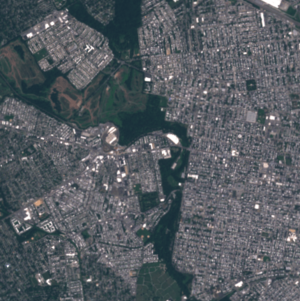
Millbourne is located at 39°57′48″N 75°15′14″W / 39.96333°N 75.25389°W. It is the smallest town in Delaware County. Millbourne is bordered by Cobbs Creek to the north and east, and by Market Street to the south. Across Cobbs Creek is a part of Fairmount Park and the Cobbs Creek Golf Course.
Parks and Recreation
Cobbs Creek
Cobbs Creek is a popular spot near Millbourne. People use the creek for swimming and fishing. There's also the Cobbs Creek trail for hiking and biking. The Cobbs Creek Bikeway starts near Millbourne and is used by walkers and cyclists.
Wister Drive Park
A small playground for children is located at the end of Wister Drive. The park was improved in 2012 with new playground equipment.
Town Layout and Buildings
Housing construction in Millbourne started in the 1900s. Samuel Shoemaker and John L. Fry built about 100 semi-detached homes. In the 1950s, new elevated townhomes called "Millbourne Gardens" were built. About 60% of Millbourne's population lives in these residential areas.
Millbourne has many different styles of buildings. Homes are mostly built with bricks and hardwood. These materials were chosen because they look nice.
Climate
Millbourne has a Humid subtropical climate. This means it has warm, wet summers and cold, snowy winters. Temperatures usually range from 26°F (-3°C) to 86°F (30°C). It rarely gets colder than 13°F (-10°C) or hotter than 94°F (34°C).
July is the hottest month, with average highs above 77°F (25°C). January is the coldest month, with average highs below 49°F (9°C).
Millbourne has wet days, meaning at least 0.04 inches (0.10 cm) of rain or snow. The wetter season is from March to August. July has the most wet days, averaging 11.1 days. The drier season is from August to March, with January having the fewest wet days. Rain is the most common type of precipitation.
Snowfall varies throughout the year. The snowy period is from November to March, with February getting the most snow, averaging 6.3 inches. From March to November, there is very little to no snow.
| Climate data for Millbourne (Philadelphia Area) (1991–2020 normals) | |||||||||||||
|---|---|---|---|---|---|---|---|---|---|---|---|---|---|
| Month | Jan | Feb | Mar | Apr | May | Jun | Jul | Aug | Sep | Oct | Nov | Dec | Year |
| Mean daily maximum °F (°C) | 41.3 (5.2) |
44.3 (6.8) |
52.8 (11.6) |
64.7 (18.2) |
74.4 (23.6) |
83.2 (28.4) |
87.8 (31.0) |
85.8 (29.9) |
78.9 (26.1) |
67.2 (19.6) |
55.9 (13.3) |
46.0 (7.8) |
65.2 (18.5) |
| Daily mean °F (°C) | 26.0 (−3.3) |
27.5 (−2.5) |
34.3 (1.3) |
44.3 (6.8) |
54.2 (12.3) |
63.9 (17.7) |
69.6 (20.9) |
67.9 (19.9) |
69.9 (21.1) |
58.2 (14.6) |
38.8 (3.8) |
31.2 (−0.4) |
48.8 (9.3) |
| Mean daily minimum °F (°C) | 33.7 (0.9) |
35.9 (2.2) |
43.6 (6.4) |
54.5 (12.5) |
64.3 (17.9) |
73.5 (23.1) |
78.7 (25.9) |
76.8 (24.9) |
60.9 (16.1) |
49.2 (9.6) |
47.4 (8.6) |
38.6 (3.7) |
54.8 (12.6) |
| Average precipitation inches (mm) | 3.13 (80) |
2.75 (70) |
3.96 (101) |
3.47 (88) |
3.34 (85) |
4.04 (103) |
4.38 (111) |
4.29 (109) |
4.40 (112) |
3.47 (88) |
2.91 (74) |
3.97 (101) |
44.11 (1,122) |
| Average snowfall inches (cm) | 7.1 (18) |
8.4 (21) |
3.6 (9.1) |
0.3 (0.76) |
0.0 (0.0) |
0.0 (0.0) |
0.0 (0.0) |
0.0 (0.0) |
0.0 (0.0) |
0.0 (0.0) |
0.2 (0.51) |
3.5 (8.9) |
23.1 (58.27) |
| Source: NOAA | |||||||||||||
People of Millbourne
| Historical population | |||
|---|---|---|---|
| Census | Pop. | %± | |
| 1910 | 322 | — | |
| 1920 | 418 | 29.8% | |
| 1930 | 396 | −5.3% | |
| 1940 | 393 | −0.8% | |
| 1950 | 901 | 129.3% | |
| 1960 | 793 | −12.0% | |
| 1970 | 637 | −19.7% | |
| 1980 | 652 | 2.4% | |
| 1990 | 831 | 27.5% | |
| 2000 | 943 | 13.5% | |
| 2010 | 1,159 | 22.9% | |
| 2020 | 1,212 | 4.6% | |
Population Facts
2020 Census
In 2020, Millbourne's population was 1,212 people. The racial makeup was 7.1% White, 20% African American, 0.1% Native American, and 63.2% Asian. About 6.2% were from other races, and 3.3% were from two or more races. Hispanic or Latino people made up 6.5% of the population. A large part of the population, 63.8%, was born outside the United States.
There were 346 households. About 24.3% of households had children under 18. The average family size was 3.64 people. The median age in Millbourne was 31 years old.
Cultural Diversity
In the 1980s, most people in Millbourne were Greek Americans and East Asians. Since the 2000s, Millbourne has become the first town in Pennsylvania with a majority of Desi people (from the Indian subcontinent). Because of this, Millbourne is often called a "Little India." Many residents live there for a few years until they are financially stable, then move to other places.
Religion
Millbourne and the nearby area have many different religious places. There are about 16 churches, temples, and mosques. These include the Philadelphia Sikh Society, Philadelphia Korean Baptist Church, Sree Narayana Guru Deva Temple, and Ethiopian Evangelical Church of Philadelphia.
Philadelphia Sikh Society
The Philadelphia Sikh Society is a gurdwara (Sikh temple) on Garden Court. It has been Millbourne's only place of worship since the 1990s. It started when a small Sikh community in Philadelphia needed a larger space. They bought an old warehouse in Millbourne and turned it into a gurdwara. This move helped the Sikh population in Millbourne grow a lot. The gurdwara holds prayer services every Sunday and Friday. Each year, they have a parade to celebrate Guru Nanak, the founder of Sikhism. About 1,500 Sikhs visit the gurdwara.
Languages
According to the 2020 Census, 73.4% of people in Millbourne spoke a language other than English at home. Only 26.6% of households spoke only English. About 49.9% spoke an Indo-European language, and 12.7% spoke an Asian and Pacific Islander language.
Economy
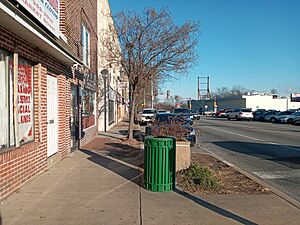
Millbourne used to depend on taxes from the Sears store. When Sears closed in 1988, the town faced financial problems. In 1993, Pennsylvania declared Millbourne a financially distressed municipality. This meant the state helped the town recover. Taxes for homeowners increased.
In the 2000s, Millbourne started taxing the land itself, not the buildings. This helped raise money. The old Sears lot became a big source of income. On October 21, 2014, Millbourne was no longer considered financially distressed.
In 2012, there were plans to develop the vacant 18-acre plot where Sears used to be. The plans included shops, homes, and a new town hall. However, these plans were canceled. On October 7, 2022, after seven years of planning, the Children's Hospital of Philadelphia opened a logistics facility at the former Sears lot. This new facility greatly increased the value of the site.
In 2020, the average income for a household in Millbourne was $45,800. About 10.9% of the population lived below the poverty line. The top three industries where Millbourne residents work are retail, recreation and food services, and administrative and waste management.
Grants and Improvements
Millbourne has received grants (money from the government or other organizations) to improve its infrastructure. These grants helped improve the town center, support recycling programs, develop the Children's Hospital facility, and plan for new businesses near Millbourne Station.
Education
Millbourne School District History
In the 1950s, Millbourne students went to East Lansdowne Elementary and Aldan High School. In the late 1960s, Delaware County began combining school districts. Millbourne wanted to stay independent, but the Pennsylvania Supreme Court decided it should merge. The Millbourne School District closed in 1971. It joined with other towns to form the Upper Darby School District.
Upper Darby School District Today
Today, students from kindergarten to 12th grade attend Upper Darby School District schools.
- Kindergarteners go to the Upper Darby Kindergarten Center.
- Grades 1–5 attend Charles Kelly Elementary School.
- Grades 6–8 attend Beverly Hills Middle School.
- Grades 9–12 attend Upper Darby High School.
All these schools provide bus transportation for students in Millbourne.
Education Statistics
According to the 2020 Census, 30.2% of Millbourne's population has a bachelor's degree or higher. About 19% have a high school diploma.
About 64.4% of students in Millbourne are in K-12 schools. About 21.5% are in undergraduate colleges.
Culture
Art and Murals
Millbourne Station is decorated with metal iridescent peacock feathers. This art project, called "Paradise," was designed in 2009. It celebrates the diverse culture of Millbourne, especially its people from the Indian sub-continent. There is also a community-made mural next to the station. It shows Millbourne and its residents.
Food and Groceries
Millbourne doesn't have its own special cuisine. However, there are many ethnic grocery stores and restaurants in Millbourne and nearby Upper Darby. These places offer a wide variety of Indian, Bengali, and Punjabi foods and fresh ingredients for the South Asian residents.
Media
News and Radio
Millbourne does not have its own daily newspaper. It is covered by The Delaware County Daily Times and The Philadelphia Inquirer. Millbourne also has access to the same radio channels as the rest of the Philadelphia metropolitan area.
Television
Millbourne can receive the same television channels as the Philadelphia metropolitan area. Millbourne was featured on WPVI-TV's Visions 2011 because of its large Indian population. An episode of Postcards from Buster called Philadelphia Masala was set in Millbourne. It aimed to teach children about Sikh culture.
Infrastructure
Transportation
Roads
As of 2013, Millbourne had about 1 mile of public roads. All of these roads are maintained by the town. Pennsylvania Route 3 is the main highway serving Millbourne. It forms the town's southern border. This road was once called West Chester Pike but is now named Market Street, like the street in Philadelphia.
Residents in Millbourne pay for parking permits. There are also parking meters on Wister Drive and Chatham Road. In Delaware County, people can pay for parking using mobile applications.
Public Transportation
Millbourne station is located at the end of Sellers Avenue. It is owned and operated by SEPTA. Trains from this station go west to 69th Street Transportation Center and east to Frankford Transportation Center. The station was modernized in 2007 as part of SEPTA's plan to improve the Market-Frankford Line.
Utilities
Recycling is collected every Wednesday in Millbourne. Regular trash-pick-up happens every Thursday and Friday.
Electricity in Millbourne is provided by the PECO Energy Company. Water services are provided by Aqua America.
Different types of internet are available in Millbourne, including ADSL, Cable, Fiber, and Fixed Wireless. Comcast Cable Communications, LLC provides most of the cable internet. 5G mobile internet is available from Verizon Wireless, AT&T Mobility, and T-Mobile.
See also
 In Spanish: Millbourne para niños
In Spanish: Millbourne para niños




